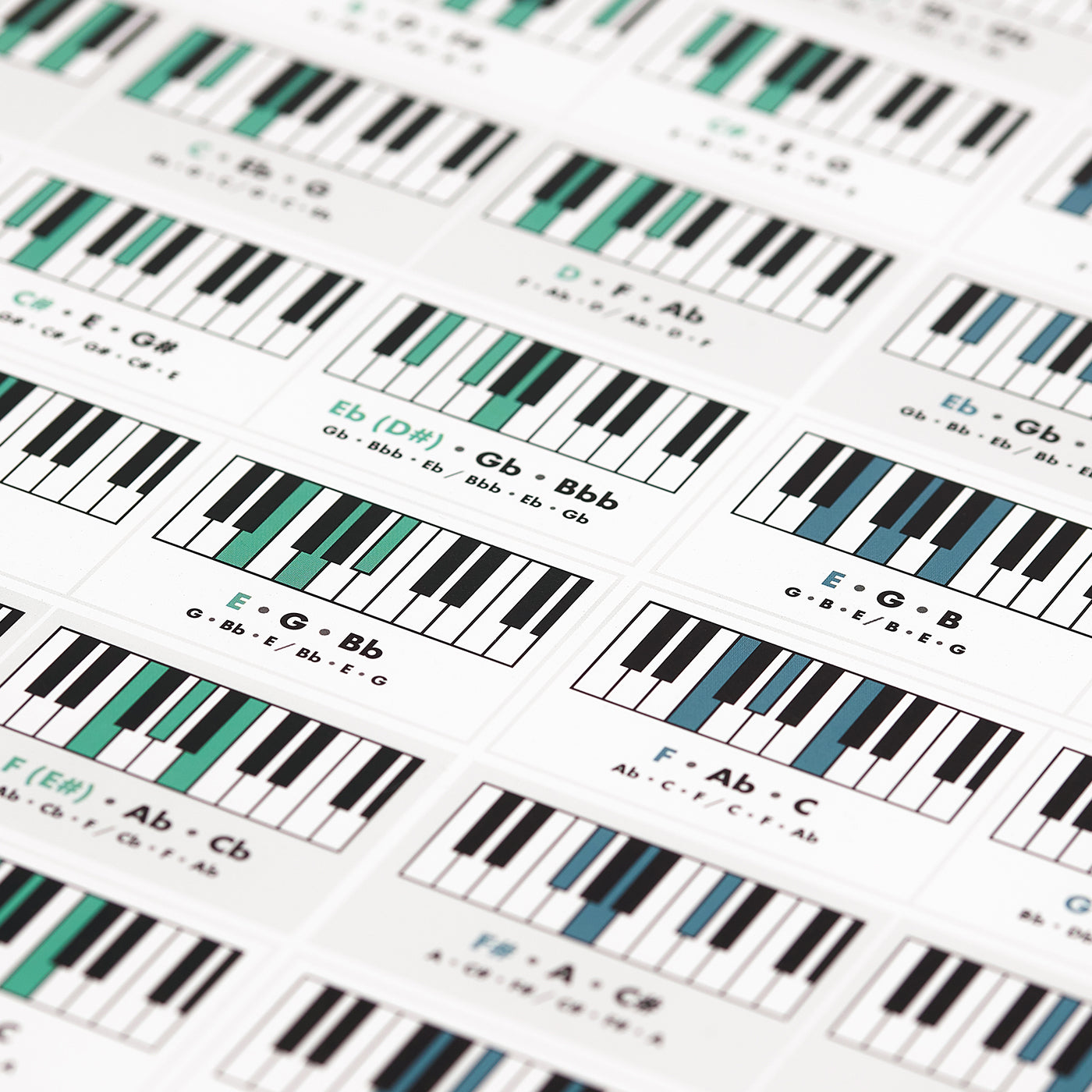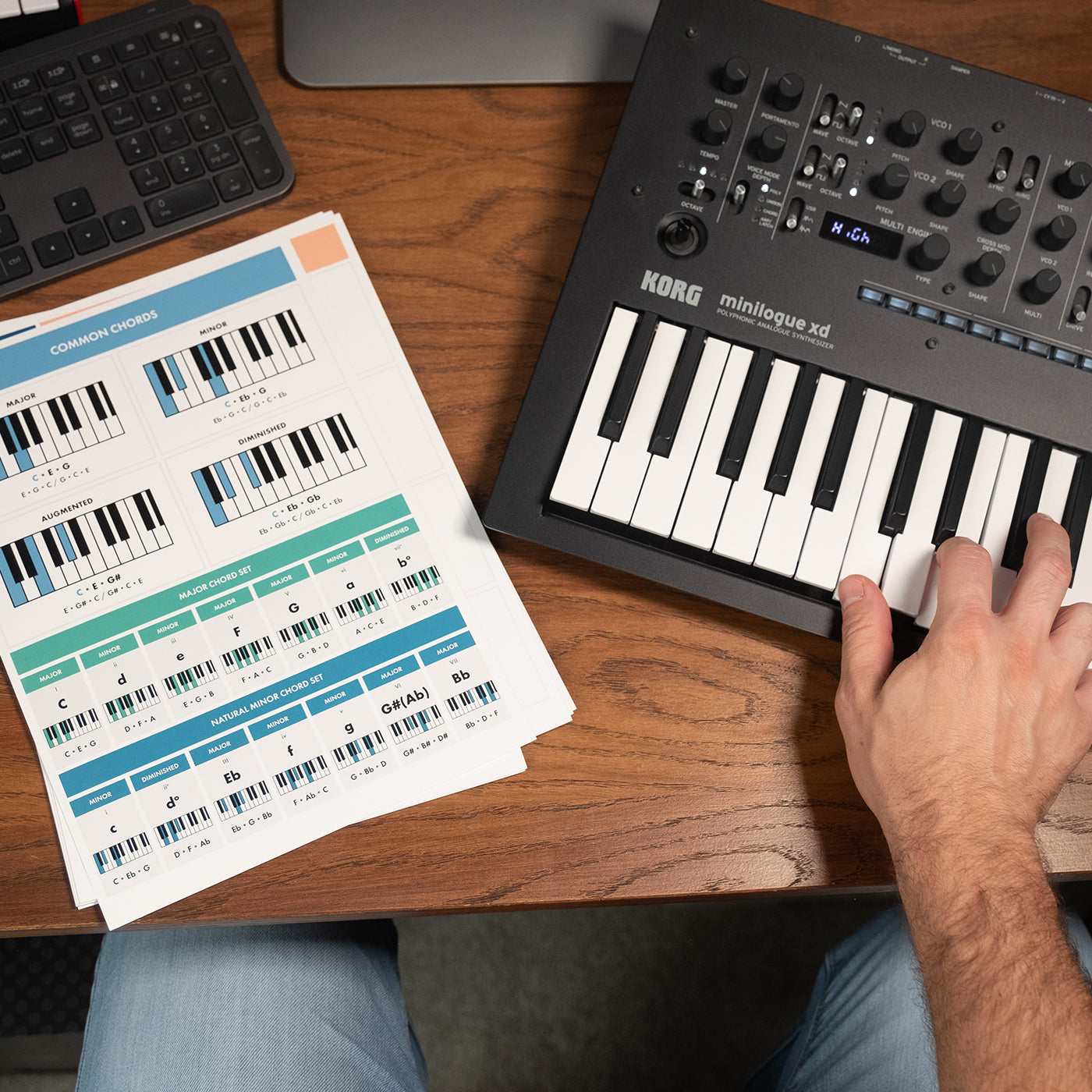The Really Useful Chord Progression Poster includes easy-to-read diagrams of all 24 major and minor chord sets. The poster covers everything you need to create interesting chord progressions and jam away to your heart's content.
Piano players and producers at any stage of their musical journey. Pianists can use the poster as they practise to advance their learning, and it’s packed with practical information to help music-makers bring their ideas to life. It makes song writing quicker and easier and explains the theory behind the creative process. Whether you’re making music on a piano, a keyboard, or a computer, you’ll learn by doing with this illustrated poster.
Pianists can use the poster to practise chord progressions until they’re committed to muscle memory. Each diagram comes with suggested fingerings which teach you the ‘right’ way to play them. The Really Useful Chord Progression Poster is fully illustrated, so it doesn’t matter if you can’t read classical music notation. Whatever level you’re playing at, this poster will help you to get more out of your practice sessions.
If you’re a producer, you’ll love this poster because it simplifies the song-writing process. It will teach you about complementary chords and progressions so that you can make music more intuitively. Before long you’ll be creating catchier hooks and laying down better beats.

A chord is a collection of two or more notes that are played together at the same time. You can choose any notes you like to create a chord. But it’s worth learning the most common chord types, as they appear in many popular pieces of music.
Major, minor, augmented and diminished. Those 4 chord types have created the world’s most beautiful songs. Once you understand how they’re formed, you can play and improvise with the best of them.
Just as a drumbeat provides rhythm, chords give structure to a song. They’re also a great way to create emotion. Chords are built using combinations of intervals - which means the distance between one note and another. By using different interval patterns, you can create distinct moods. This is how chords and chord sequences add suspense, sorrow or joy to a piece.
When you become familiar with each chord type, you can pick the perfect chords for any arrangement.
The Really Useful Chord Progression Poster contains visual diagrams of all 24 major and minor chord sets. The chords are displayed in a large, easy-to-read format, with their notes written underneath them. This means you can instantly access all the notes you need, rather than having to figure out how to build each chord manually. Use this poster every time you practise, and you’ll soon be playing chords with ease.

A scale is a collection of notes, played in a particular order. Scales can start on any note and each has its own distinct sound.
Scales provide useful sets of notes, which sound good when played together. When you know which notes are in each scale, then it’s easier to riff and create new music.
Mastering your scales is a bit like learning how to touch-type. By practising them frequently you’ll improve your coordination and fluency. Once you’ve nailed your scales, you’ll be able to play with confidence. The more you practise them, the quicker you’ll commit them to memory!
The Really Useful Chord Progression Poster teaches you about 4 of the most common scales: major, natural minor, harmonic minor and melodic minor. The poster is fully illustrated, which means that there’s no sight-reading necessary.

A chord progression is made up of multiple chords played in succession. Much like individual chords, chord progressions create a sense of atmosphere. They work alongside the melody of a song to give it structure.
Each major and minor scale has its own set of 7 triad chords. All of these chords work well when played together because they’re made up of notes from the same scale. By memorising these chord sets you’ll become a more intuitive player and songwriter. Over time, they’ll help you to pick up music by ear and create more interesting compositions.
The Really Useful Piano Poster covers the major and natural minor chord sets for each key signature. The chord sets are laid out in an accessible, visual format - so you don’t have to take the time to work them out yourself. Just refer back to your poster and you’ll be able to jam chord progressions in any key.

Music theory is the study of the rules and concepts that underpin every piece of music. It covers a huge range of topics, including scales, modes, musical terminology, harmonies, notation and much more.
You don’t have to study music theory in order to make and play music - but it definitely helps. If you can get to grips with the fundamentals, then you’ll be able to understand the instinctive choices you make when you play. The more you learn, the more informed your decisions will be. Think of music theory as a tool that can improve your performance and speed up the song writing process.
By learning the theory behind chord progressions you’ll get a better understanding of how songs are created. This will help you to pick up music by ear and improve your own song-writing ability. With each purchase you’ll also immediately receive a free digital version of The Really Useful Chord Progression Poster.So you can get practising straight away!
Free 2-day shipping to the UK
Worldwide shipping is charged at £15
Free digital download with this product
This product ships in a postal tube
Each tube weighs approximately 405g / 0.9lb
Each poster measures 594 x 841mm / 23.4 x 33.1in
We offset our carbon footprint via Ecologi
We use 100% recyclable paper and packaging

If your order includes digital downloads, you will be able to download it immediately from the Order Confirmation page. You will also receive an email with a link to download the file, which you can keep for your records.
No! All our products are Designed to be understood by anyone, of any age, and any ability. They’re practical guides that help you shortcut the learning process by giving you the information you need, nothing more. And they’re fully illustrated, so there’s no traditional musical notation involved. That’s why we call our products ‘Really Useful’!.
All printed posters are A1 in size (33.1 x 23.4 inches / 841 x 594 mm). Depending on whether you order the ‘rolled’ or the ‘folded’ version, your poster may or may not arrive folded to A4 (11.7 x 8.3 inches / 297 x 210 mm) for easy shipping. If you’d like to frame your poster, you can take it to a local framer or purchase a suitable frame online.
Once your order is dispatched you will receive a tracking number via email. You can then track your item here: https://www.royalmail.com/track-your-item#/ More info can be found on our shipping page.